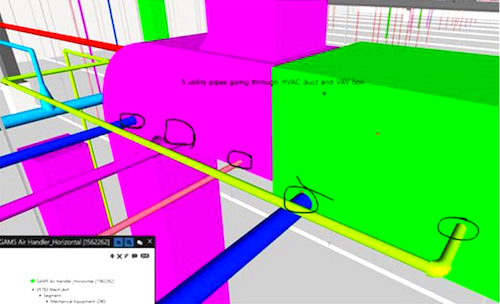If you’re building a new facility, upwards of 50 people could be working on its design model at the same time. From electrical and mechanical engineers to architects and refrigeration specialists, it takes a team of experts from multiple disciplines to design a building and bring it to life.
So how do you know if your AEC firm is building your facility’s design model efficiently? If they’re not using smart technology, your project timeline could be longer than it has to be.
What is automated clash detection?
In general, clash detection is the identification of instances in 3D modeling where the elements of different models occupy the same space, causing a “clash.” For example, if an architect designs a column into the model, you couldn’t place a door in the same place — that would create a clash.
Clash detection is a standard tool in building information modeling (BIM), but advanced firms take this functionality and make it smarter by attaching metadata to it. This automated (or intelligent) clash detection software runs in the background, detecting discrepancies that may not have otherwise been caught.
As you can imagine, this reduces error and saves time; engineers and designers spend less time trying to manually find clashes and more time moving the project forward.
How does automated clash detection work?
The design world has made a major shift from AutoCAD to Revit software, and it’s as significant as the jump from hand-drawing to AutoCAD was. The entire model now lives in one central location with the entire team working off of the same model.
Here’s how it works: Team members from each discipline input their own data into the model, working on it in real-time so they can see conflicts as they arise. Meanwhile, the program runs the intelligent clash detection in the background to catch any discrepancies between the data contributed from different disciplines (architectural versus structural, for example) that live in that same, central model.
Compare this to the previous method with AutoCAD: Everyone worked on their own models and then came together to compare notes and detect discrepancies by hand. All the designers would be pulled into a conference room to lay their 2D plans on top of each other. Now, they can virtually walk through a 3D model to find conflicts and clashes before they even happen.
Again, with up to 50 team members working on the same model at the same time, the pace moves quickly, so having automated clash detection is critical to ensuring the design process moves smoothly and efficiently.

Do I need to work with a firm that uses automated clash detection?
Automated clash detection allows engineers and designers toggle various models on and off, work faster and collaborate more efficiently. To be honest, if an AEC firm isn’t using this technology, they are going to be left behind.
This isn’t just about making life easier for designers and engineers, though. The real benefits are passed on to their clients: you. How? Since this efficient clash detection helps catch conflicts before materials arrive on the job site, it prevents ordering unnecessary materials and unexpected change orders, saving your project time and money.
Another plus is that some design-build firms, like Stellar, have been able to integrate the 3D aspect with their construction teams, allowing them to walk the model and see what the building is going to look like before they pour concrete.
It also gives the construction team insight into the sequence of operations. In other words, they don’t just have a static model to look at, but rather can see where to begin, what walls to put up first and how long to delay roof construction to allow for equipment installation. They can more easily markup the model and ask the engineers questions.
Instead of the design team simply handing everything off to the construction team, there’s now a more collaborative effort, which allows the entire firm to work at a faster pace.
Automated clash detection in action
We recently worked on a multi-story building for a client that had process equipment on five different levels. The facility was nearly 200 feet tall, which is unusual since most process buildings are typically built horizontally.
Having access to the 3D model and construction sequencing on the job site saved our team months of planning. For example, we had a 32-foot water tank that needed to be installed in the middle of the fourth floor, but there was a 10-foot HVAC duct perpendicular to where that tank needed to be. Our team was able to plan for installing the water tank first in order to expedite construction and avoid backtracking, compared to if the HVAC duct had gone in first.
Automated clash detection is just one facet of the many cutting-edge design tools that are making construction projects smarter, faster and more cost-effective. Learn about other technologies in our free guide, “6 Must-Have Design Technology Tools for Your Next Food Plant Project.”
If you have other questions about automated clash detection and how it could benefit your next facility, email me at foodforthought@stellar.net




